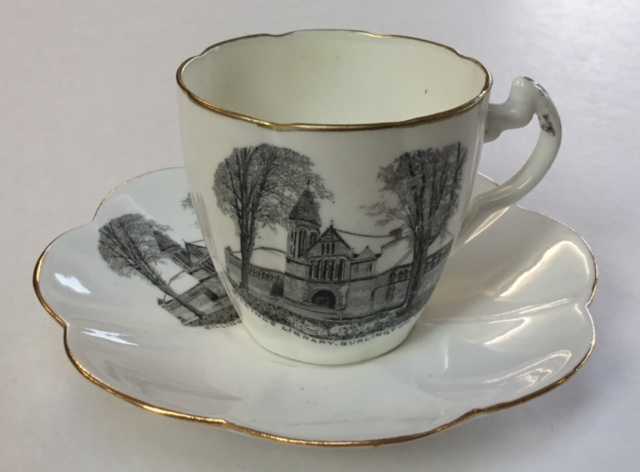One of the best parts of working in a library is that there is always something to discover (or rediscover) in the collections. While preparing for our move to new quarters in the Billings Library, we came across an unassuming carton—the kind that we use all of the time to store manuscripts, serials, and other materials—labeled “FRAGILE: Realia from wooden display case.”
Inside the container, just as the label had promised, was a small stash of everyday objects that once stood on display in our old quarters at the Howe Library. Ranging from a Vermont politician’s box of keepsakes to turn-of-the-century toothpaste manufactured by Burlington’s Wells & Richardson Co., these artifacts have entered our collection over the years as individual gifts or as parts of larger donations of written or printed materials. Even when an artifact’s provenance has been clear, though, its story—how its owner came to possess it, the role it played in its owner’s life, and the social ties linking the individuals that passed the object through the generations—has often been hidden in the threads of fraying memories. Nothing stays buried forever, however, and with a little digging and a lot of determination, one can unearth the stories of these objects and their place in our history.
In this artifact spotlight, we highlight a fitting find from our cache of objects: a partial set of Billings Library souvenir whiteware. The saucer and two teacups each feature a transfer-printed image of the library, beneath which is printed “Billings Library, Burlington, VT, U.S.A.” A trade mark on the foot of each piece declares its point of departure and destination: “Made in England: C.G. Peterson, Burlington, Vermont.” Another mark on one teacup’s foot supplies a design registration number.
The story of our “Billings-ware” begins with this registry mark, which was assigned by the English Patent Office. The registration number for the design on our whiteware falls near the end of the range of numbers assigned in 1888, three years after the dedication of the Billings Library. The Billings-ware, then, would have arrived in Vermont when the public was enamored of the new building and eager to “buy” and claim a piece of the library for themselves.
The trade marks on the artifacts link this period of enthusiasm for the library to one of the many Burlington merchants who capitalized on the public’s craving for Billings keepsakes. Individuals wishing to admire the library’s beauty as they drank their tea and coffee could purchase crockery like our Billings-ware from the shop of Charles G. Peterson, a home furnishings dealer in downtown Burlington from 1877 to 1906. Peterson’s shop sold everything from glassware to wallpaper, catering to the needs of locals and tourists alike. Customers could purchase souvenir crockery featuring a variety of Burlington buildings and landmarks, including butter dishes commemorating the dedication of the Fletcher Free Library and cups and saucers depicting the Ethan Allen Monument.
Although its design was registered in 1888, the Billings-ware was first advertised in 1890. Just before Christmas, the Burlington Free Press announced that “Mr. C. G. Peterson has just received a large lot of fine English China made to order which bears fine representations of the Billings Library.” Peterson ran advertisements for the Billings souvenirs in the UVM yearbook, the student newspaper, and the Free Press from 1890 through 1895.
Although we do not know who purchased our Billings-ware from Peterson’s shop, we do know that the pieces ultimately came into the hands of UVM alumna Roberta F. Powers (class of 1932), who donated them to Special Collections in 1984. Powers was the youngest daughter of George M. Powers (UVM 1883), who served intermittently as a justice on the Vermont Supreme Court between 1904 and 1938. While pursuing a bachelor’s degree in philosophy, Roberta Powers took part in several honor societies and student organizations relating to theater, literature, and debate, and received honors and scholarships for her “literary scientific” coursework. The editors of 1932 year book described Powers as “a dynamo” who “radiate[d] personality, friendliness, and ability in all directions.” Her witty and thoughtful observations in her father’s biography, which she composed during the last decade of her life, evidence the truth of these claims.
It was during this period of biographical research, as she was weaving together the threads of her family’s history, that Roberta Powers donated the Billings teaware, a piece of UVM’s history, to Special Collections. As we settle into Silver Special Collections here in the renovated Billings Library, these souvenirs remind us how highly the community regarded H. H. Richardson’s architectural landmark on the UVM campus.
This post was contributed by Hannah Johnson, who graduated from UVM in 2018 with a degree in English and History. Hannah worked in Special Collections as a student and joined our staff full-time this fall.


